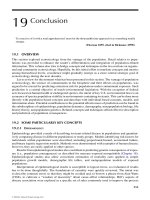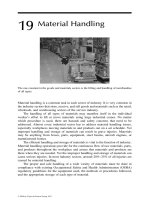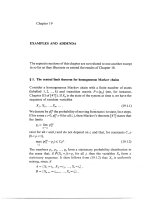Chapter 19
Bạn đang xem bản rút gọn của tài liệu. Xem và tải ngay bản đầy đủ của tài liệu tại đây (274.1 KB, 19 trang )
<span class='text_page_counter'>(1)</span>MANAGERIAL ECONOMICS 12th Edition. By Mark Hirschey.
<span class='text_page_counter'>(2)</span> Government in the Market Economy Chapter 19.
<span class='text_page_counter'>(3)</span> Chapter 19 OVERVIEW . Externalities Solving Externalities Public Goods Optimal Allocation of Social Resources Benefit‑Cost Concepts Benefit-Cost Criteria Additional Methods for Improving Public Management Regulatory Reform in the New Millennium Health‑Care Reform.
<span class='text_page_counter'>(4)</span> Chapter 19 KEY CONCEPTS . negative externality positive externality internalize the externality Pigovian taxes command-and-control regulation public good nonrival consumption private good rival consumption nonexclusion concept nonexclusionary exclusion concept common resources tragedy of the commons free‑rider problem hidden preferences problem. . Pareto satisfactory Pareto optimal potential Pareto improvement marginal social costs marginal external costs marginal private costs marginal social benefits marginal private benefits marginal external benefits social rate of discount social net present-value benefit‑cost ratio analysis social internal rate of return cost‑effectiveness analysis privatization.
<span class='text_page_counter'>(5)</span> Externalities . Negative Externalities . . . Air, noise, and water pollution are familiar negative externalities. Negative externalities cause overproduction because sellers do not consider all social costs.. Positive Externalities . Education generates positive externalities. Positive externalities cause underproduction because sellers cannot reflect the full social value of production in the prices charged..
<span class='text_page_counter'>(6)</span>
<span class='text_page_counter'>(7)</span>
<span class='text_page_counter'>(8)</span> Solving Externalities . Government Solutions . . Taxes are often used to correct negative externalities. Government sometimes controls the effects of externalities by regulation.. Market Solutions . . Markets can provide effective penalties to moderate negative externalities. Markets can give incentives for the production of goods and services with positive externalities..
<span class='text_page_counter'>(9)</span> Public Goods . Rivalry and Exclusion . Public goods are nonrival in consumption. • Use by certain individuals does not reduce availability for others.. . Public goods tend to be nonexclusionary. • It is often impossible to confine benefits to paying customers.. . Free Riders and Hidden Preferences . Free‑riders enjoy benefits at no cost. Hidden preferences can exist for public goods..
<span class='text_page_counter'>(10)</span>
<span class='text_page_counter'>(11)</span>
<span class='text_page_counter'>(12)</span> Optimal Allocation of Social Resources . Pareto Improvement . . . If a public project makes at least one individual better off and no one worse off, then the project is Pareto satisfactory. When all such projects have been undertaken, the situation is deemed Pareto optimal.. Marginal Social Costs and Benefits . . Optimal allocation of social resources requires balancing marginal social costs and benefits. MSC = MSB at optimum..
<span class='text_page_counter'>(13)</span> Benefit‑Cost Methodology . Benefit-Cost Concepts . . . Statement of objectives. Discussion of alternatives. Quantification of related costs and benefits. Selection of a criterion for acceptable project determination. Specification of an appropriate social discount rate.. Social Rate of Discount . Determining the true cost of social capital is crucial..
<span class='text_page_counter'>(14)</span>
<span class='text_page_counter'>(15)</span> Benefit-Cost Criteria Social . Net Present-Value. Invest when SNPV > 0. Do not invest when SNPV < 0.. Benefit‑Cost . Invest when B/C > 1. Do not invest when B/C < 1.. Internal . Ratio. Rate of Return. Invest when SIRR > k. Do not invest when SIRR < k..
<span class='text_page_counter'>(16)</span> Additional Methods for Improving Public Management Cost‑effectiveness . . Analysis. Purpose is to determine how to best employ resources in a given social program. Useful when output is difficult to express in monetary terms.. Privatization . Public‑sector resources are transferred to the private sector in the hope that the profit motive might spur higher product quality, better customer service, and lower costs..
<span class='text_page_counter'>(17)</span> Regulatory Reform in the New Millennium Promoting. Competition in Electric Power Generation . Setbacks limit future potential.. Fostering. Competition in Telecommunications . Emerging competition battles larger rivals.. Reforming. Environmental Regulation Improving Regulation of Health and Safety.
<span class='text_page_counter'>(18)</span> Health‑Care Reform Managed . . Uncontrolled increases in health‑care expenditures and a growing number of uninsured pose daunting challenge. Reforms seek to expand access to health insurance and improve health‑care services.. Outlook . Competition. for Health‑care Reform. Economic incentives help control costs, improve access, and give consumers the quality of healthcare that they want..
<span class='text_page_counter'>(19)</span>
<span class='text_page_counter'>(20)</span>









